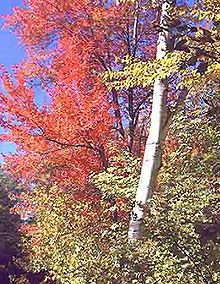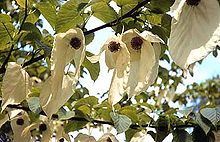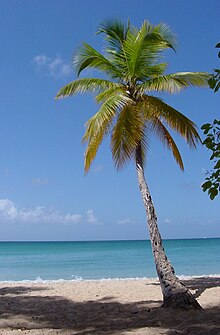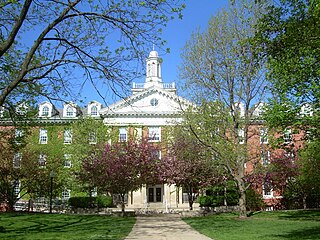Flowering plants (Magnoliophyta; angiosperms)
For classification of flowering plants, see APG II system.
Eudicots (together with magnoliids they are called broadleaf or hardwood trees)

About 210 eudicot families include trees. [1] [2]
- Adoxaceae (Moschatel family)
- Altingiaceae (Sweetgum family)
- Liquidambar , Sweetgum
- Anacardiaceae (Cashew family)
- Anacardium , Cashew etc.
- Mangifera , Mango
- Pistacia , Pistachio etc.
- Rhus, Sumac
- Toxicodendron , Lacquer tree etc.
- Apocynaceae (Dogbane family)
- Aquifoliaceae (Holly family)
- Ilex, Holly
- Araliaceae (Ivy family)
- Harmsiopanax
- Kalopanax septemlobus, Kalopanax

Birch tree (foreground) and maple tree (background) in fall. - Schefflera, Schefflera
- Betulaceae (Birch family)
- Bignoniaceae (Trumpet Creeper family)
- Cactaceae (Cactus family)
- Carnegiea gigantea, Saguaro
- Cannabaceae (Cannabis family)
- Celtis, Hackberry
- Cornaceae (Dogwood family)
- Cornus, Dogwood
- Family Dipterocarpaceae

- Ebenaceae (Persimmon family)
- Diospyros, Persimmon
- Ericaceae (Heath family)
- Arbutus, Arbutus
- Eucommiaceae (Eucommia family)
- Eucommia ulmoides, Eucommia
- Fabaceae (Pea family)
- Acacia, Acacia
- Bauhinia Orchid tree etc.
- Caesalpinia, Brazilwood etc.
- Gleditsia , Honey locust etc.
- Laburnum, Laburnum
- Robinia , Black locust etc.
- Fagaceae (Beech family)
- Castanea, Chestnut
- Fagus, Beech
- Lithocarpus , Tanoak etc.
- Quercus, Oak

- Fouquieriaceae (Boojum family)
- Fouquieria , Boojum etc.
- Hamamelidaceae (Witch-hazel family)
- Parrotia persica, Persian Ironwood
- Juglandaceae (Walnut family)
- Lecythidaceae (Paradise nut family)
- Bertholletia excelsa, Brazil Nut
- Lythraceae (Loosestrife family)
- Lagerstroemia, Crape-myrtle
- Malvaceae (Mallow family; including Tiliaceae, Sterculiaceae and Bombacaceae)

African baobab (Adansonia digitata, Malvaceae) in South Africa. - Adansonia, Baobab
- Bombax, Silk-cotton tree
- Brachychiton, Bottletrees
- Ceiba , Kapok etc.
- Durio, Durian
- Ochroma pyramidale, Balsa
- Theobroma , Cacao etc.
- Tilia, Linden (Basswood, Lime)
- Meliaceae (Mahogany family)
- Azadirachta , Neem etc.
- Melia , Bead tree etc.
- Swietenia, Mahogany
- Moraceae (Mulberry family)
Eucalyptus bridgesiana (Myrtaceae) on Red Hill, Australian Capital Territory. - Myrtaceae (Myrtle family)
- Nothofagaceaed (Southern Beech family)
- Nothofagus, Southern beech
- Nyssaceae (Tupelo family; sometimes included in Cornaceae)
- Oleaceae (Olive family)

Dove tree (Nyssaceae) in flower. - Paulowniaceae (Paulownia family)
- Paulownia, Foxglove Tree
- Platanaceae (Plane family)
- Platanus, Plane
- Rhizophoraceae (Mangrove family)
- Rhizophora , Red mangrove etc.
- Rosaceae (Rose family)

- Rubiaceae (Bedstraw family)
- Coffea, Coffee
- Rutaceae (Rue family)
- Salicaceae (Willow family)

- Sapindaceae (including Aceraceae, Hippocastanaceae) (Soapberry family)
- Acer, Maple
- Aesculus, Buckeye, Horse-chestnut
- Koelreuteria, Golden rain tree
- Litchi sinensis, Lychee
- Ungnadia speciosa, Mexican Buckeye
- Sapotaceae (Sapodilla family)
- Argania spinosa, Argan
- Palaquium, Gutta-percha
- Sideroxylon , Tambalacoque ("dodo tree") etc.

- Family Simaroubaceae
- Ailanthus, Tree of heaven
- Theaceae (Camellia family)
- Thymelaeaceae (Thymelaea family)
- Gonystylus, Ramin
- Ulmaceae (Elm family)
Monocotyledons (Liliopsida)

About 10 Monocotyledon families include trees. [1] [2]
- Asparagaceae (Asparagus family)
- Cordyline , Cabbage tree etc.
- Dracaena, Dragon tree
- Yucca , Joshua tree etc.
- Arecaceae (Palmae) (Palm family)
- Areca, Areca
- Cocos nucifera, Coconut
- Phoenix , Date Palm etc.
- Trachycarpus, Chusan Palm etc.
- Poaceae (grass family)
- Bamboos, Poaceae subfamily Bambusoideae, around 92 genera
- Note that banana 'trees' are not actually trees; they are not woody nor is the stalk perennial.
Magnoliids (together with eudicots they are called broadleaf or hardwood trees)

17 magnoliid families include trees. [1] [2]
- Annonaceae (Custard apple family)
- Annona , Cherimoya, Custard apple, Soursop etc.
- Asimina , American Pawpaw
- Lauraceae (Laureddl family)
- Cinnamomum , Cinnamon etc.
- Laurus , Bay Laurel etc.
- Persea , Avocado etc.
- Sassafras , Sassafras
- Magnoliaceae (Magnolia family)
- Liriodendron, Tulip tree
- Magnolia, Magnolia
- Myristicaceae (Nutmeg family)
- Myristica, Nutmeg
















